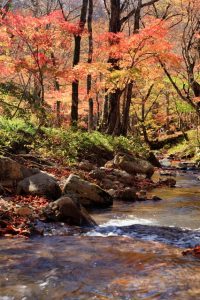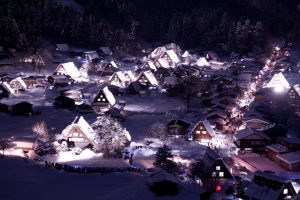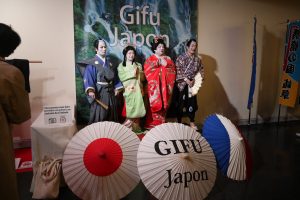 Gifu Prefecture is near the centre of Japan and Seki City within the prefecture has the auspicious and nationally known status of being the gravitational population centre of the country (using the gravitational method which in basic terms the principle of which calculates the point at which the population would balance horizontally on the head of a theoretical pin – its centre of gravity, a method used as a scientific application by everyone from Captain Cook to NASA). It’s also proud to have a variety of landscapes and is the 7th biggest size by land area as well as one of the few inland prefectures surrounded by seven prefectures. The population of Gifu is two million, ranking 17th biggest in Japan.
Gifu Prefecture is near the centre of Japan and Seki City within the prefecture has the auspicious and nationally known status of being the gravitational population centre of the country (using the gravitational method which in basic terms the principle of which calculates the point at which the population would balance horizontally on the head of a theoretical pin – its centre of gravity, a method used as a scientific application by everyone from Captain Cook to NASA). It’s also proud to have a variety of landscapes and is the 7th biggest size by land area as well as one of the few inland prefectures surrounded by seven prefectures. The population of Gifu is two million, ranking 17th biggest in Japan.
In the northern Hida Region part of the prefecture there are a range of mountains which climb to over 3000m including Ontakesan, Norikudarake and Okuhotadakesan.
In the other direction, the Kiso Three Rivers (including the Kiso River, Nagara River and Yodogawa River) flow through the fluvial Nobi Plain into the Mino region of the south, and the Nagara River central basin in particular has a clear stream so beautiful that it is renowned in throughout the country as “One of Japan’s Greatest Water Resources.”
Gifu Prefecture has a wide range of climates depending on the area, with a range of elevations, from the Hida Mountains exceeding 3000 meters to the plains at sea level. Due to these natural conditions Gifu Prefecture produces agricultural products throughout the year. The southwestern area is well known for rice due to its warm climate. Conversely, the mountainous Hida area with a high cold climate means substantial growing of vegetables such as tomato and spinach making use of the cool summer weather. Additionally, in the mountainous area, breeding of the local “Hida beef” cow is also well known as is dairy farming. As well as this the fishery industry is focused on the rivers concentrating on salmon fishing, with fish farms such as rainbow trout and local amago variety.

Historic villages of Shirakawa-gō, one of Japan’s UNESCO World Heritage Sites
Gifu Prefecture’s economy is however mainly based on manufacturing and has been since ancient times. Of all industries, the percentage of employees working in the manufacturing sector is 25%, putting Gifu into the national ranking as high as 6th biggest manufacturing region nationally (16.0% workforce in manufacturing in Japan is the average). There are distinctive local industries such as pottery, furniture and woodworking, cutlery and Mino Japanese paper.
The final thing to introduce about Gifu Prefecture is ‘jikabuki’. Unlike the more widely known kabuki (formally o-kabuki) played by professional actors, jikabuki is played by a troupe men and women of mixed ages, with active participation from the audience with the play taking place around them, with the actors and audience all together on the stage which is the epitome of jikabuki. In other words, visitors can experience a form of traditional kabuki that ordinary people have enjoyed from the Edo period, which can no longer be seen in modern kabuki commonly seen in Tokyo, with audience participation including songs and chants.
 As well as the prefecture being alive with these jikabuki traditions with a plethora of performance groups and many thriving play houses, great effort is being put into promoting this cultural heritage in other areas of Japan as well as overseas. In October of last year, a ‘Jikabuki of Gifu’ performance was held at the Maison de Japon in Paris as part of the official programme called ‘Attractions of the Regions – Festivals and Culture’ during the Japanese and French Governments jointly organised ‘Japonism 2019’, an extensive cultural season to showcase Japanese culture in Paris and other cities in France.
As well as the prefecture being alive with these jikabuki traditions with a plethora of performance groups and many thriving play houses, great effort is being put into promoting this cultural heritage in other areas of Japan as well as overseas. In October of last year, a ‘Jikabuki of Gifu’ performance was held at the Maison de Japon in Paris as part of the official programme called ‘Attractions of the Regions – Festivals and Culture’ during the Japanese and French Governments jointly organised ‘Japonism 2019’, an extensive cultural season to showcase Japanese culture in Paris and other cities in France.
After the show, the crowded venue rang with huge applause, and exclamations were heard from all over, with some comments including “though the actors were amateurs, it was powerfully expressive” as well as “I want to visit Gifu after seeing this”. Spectators also enjoyed a photo shoot with the actors. It is now hoped this event will lead to more visits to theatres in Gifu and the Prefecture continues to work further on community development and human resource development utilizing local resources in the arts and other fields as part of its international activity.

